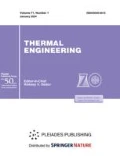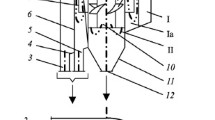Abstract
The effect of particle classification efficiency exerted on the productivity of dust-collecting systems with a ball-drum mill is considered. By using a mathematical model, the maximum productivity of dust-collecting systems with different equipment and structure has been determined, and the boundary particle size classification in a separator providing the production of dust with a preset fineness has been found. For each of the considered schemes of a dust-collecting system, a quantitative relationship is established between the system productivity, the fineness of the finished dust, and the particle classification efficiency inherent in the separators. It is shown that, for a preset fineness of the finished dust, the repeated separation of the recycled material is allowed only when the classification boundary of the particles in the main separator decreases. It is proven that the scheme with a winnowing of recycled material up to the fineness of the finished dust is unpromising since the use of a separator with an efficiency of particle classification lower than that inherent in the main separator leads to a decrease in the productivity of the dust-collecting system. In the scheme winnowing recycled material up to the fineness of the mill product wherein one can use winnowing separators having a less efficient particle separation, the productivity of the dust-collecting system depends on the dust circulation in the “main separator–winnowing separator” circuit. The productivity of the dust-collecting system depending on the fineness of the finished dust and the classification efficiency separators is determined. Schemes are recommended with a modernized main separator and with winnowing recycled material up to the size of the mill product or with a joint application of these schemes. The replacing of the main separator by a more efficient one should provide an increase in the dust-collecting system productivity by 19.2% with obtained dust having the fineness R90 = 7% and by 5.2% at R90 = 25%. The application of a scheme of winnowing up to the fineness of the mill product with a main separator should provide an increase in the productivity of a dust-collecting system by 14.0–19.4% at R90 = 7% and by 5.3–6.6% at R90 = 25%. Replacing the main separator and the winnowing of the recycled material should provide an increase in the productivity of a dust-collecting system by 28–33% at R90 = 7% and by 6.6–7.9% at R90 = 25%.
Similar content being viewed by others
References
L. A. Veretennikov, “Installation of a separator on the coal return to the ball-type drum mill,” Energetik, No. 10, 9–10 (1954).
I. K. Naimark, V. M. Pet’ko, A. I. Radzivilov, and D. G. Faershtein, “Winnowing of the return from separators during coal dust grinding,” Elektr. Stn., No. 4, 11–14 (1955).
S. P. Tsygankov, “A study of a dust system with a balltype drum mill, operating on lean coal, with additional return aspiration,” Elektr. Stn., No. 3, 10–17 (1960).
Standards for Calculation and Design of Dust Preparation Units (Gosenergoizdat, Moscow, 1958) [in Russian].
S. I. Shuvalov, S. S. Novosel’tseva, A. A. Verenin, and O. A. Voroshilov, “Mathematical model of a dust-system with a ball-type drum mill for classification scheme analysis,” Vestn. Ivan. Gos. Energ. Univ., No. 5, 10–18 (2017).
R. P. Gardner and L. G. Austin, “A study of grinding in a batch mill,” in Proceedings of the European Meeting on Grinding (Stroiizdat, Moscow, 1966), pp. 219–248 [in Russian].
S. G. Ushakov and N. I. Zverev, Inertial Dust Separation (Energiya, Moscow, 1974) [in Russian].
S. F. Shishkin and S. M. Tekhov, “Calculation of the grinding process in a closed cycle,” Izv. Vyssh. Uchebn. Zaved. Khim. Khim. Tekhnol. 34 (5), 117–119 (1991).
Author information
Authors and Affiliations
Corresponding author
Additional information
Original Russian Text © S.I. Shuvalov, A.A. Verenin, O.A. Voroshilov, 2018, published in Teploenergetika.
Rights and permissions
About this article
Cite this article
Shuvalov, S.I., Verenin, A.A. & Voroshilov, O.A. Effect of Dust-Collecting System Structure on Its Productivity. Therm. Eng. 65, 818–824 (2018). https://doi.org/10.1134/S004060151811006X
Received:
Accepted:
Published:
Issue Date:
DOI: https://doi.org/10.1134/S004060151811006X




